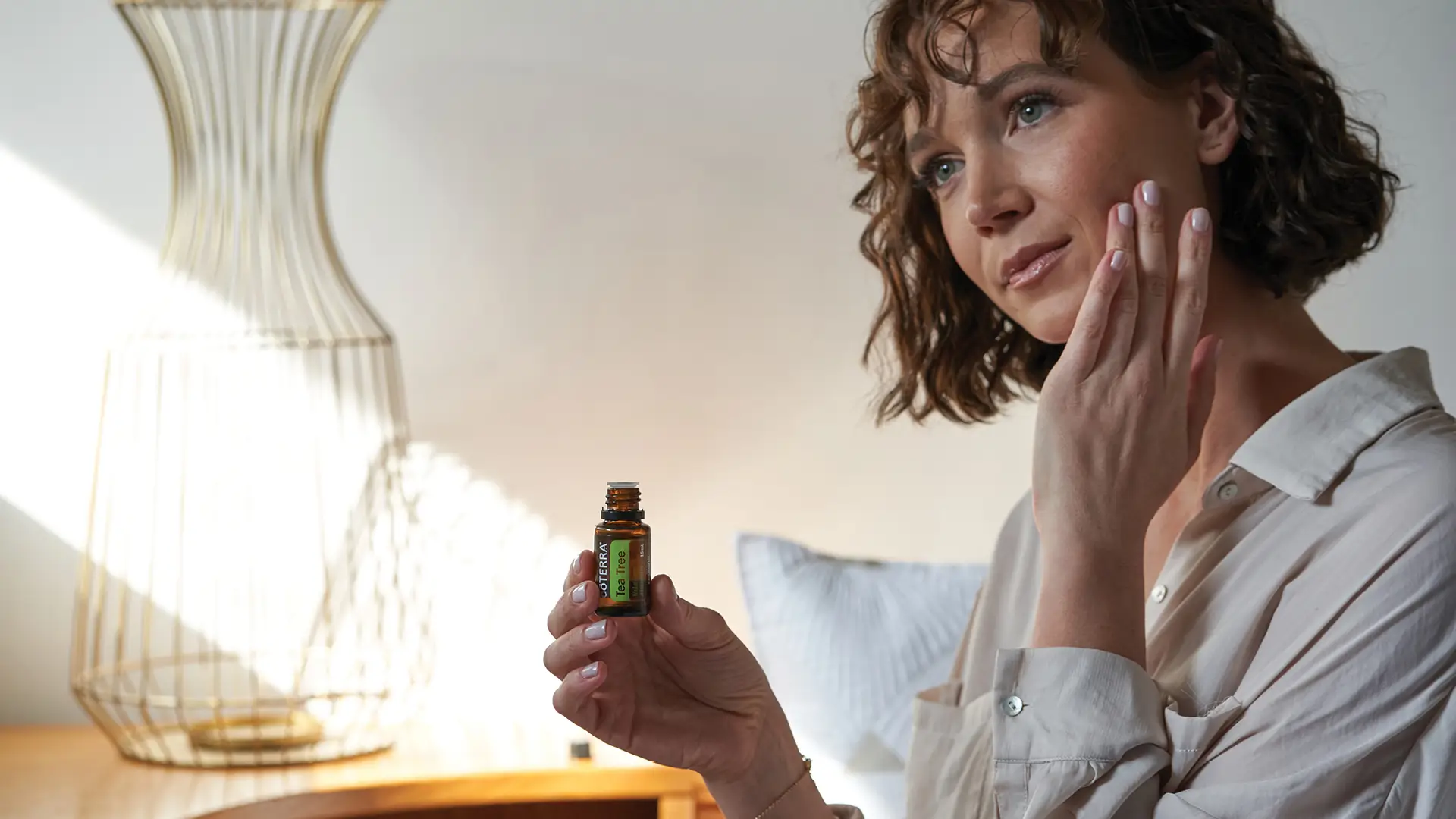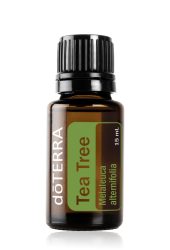
Discover the powerful benefits of dōTERRA Tea Tree Oil.
It supports clear skin, stronger immunity, and everyday relief through nature’s traditional cleansing power.
Ready to experience nature’s cleansing power?

Home » Range » Single Essential Oils » Tea Tree Oil
15 mL | Purifying and soothing




Tired of stubborn breakouts, flaky scalp, or lingering symptoms that never seem to improve?
Many people are also searching for natural, gentle ways to cleanse their homes without relying on harsh chemicals.
Dealing with stubborn blemishes, flare-ups, or blocked sinuses? You’re not alone in wanting gentler, natural relief.
Tea Tree Oil has been trusted for generations as a simple, plant-based remedy.
It’s a versatile essential oil that supports clean skin, a strong immune response, and fresh air in your home — all through traditional aromatherapy methods.
From blemish-prone skin to stubborn fungal issues or a need to detox your living space, this oil does more than refresh — it supports real wellness.
With just a few drops, you can create a safer, more natural routine for your skin, body, and home.
Tea tree oil is a powerful essential oil sourced from the leaves of the Melaleuca tree. Traditionally used in aromatherapy, it’s known for its ability to cleanse, protect, and restore — making it one of nature’s most versatile solutions.
Whether you need a natural remedy for blemishes, immune support, or household freshness, tea tree oil benefits go far and wide.
Struggling with acne, fungal skin infections, or seasonal bugs? The wide range of tea tree oil uses makes it a daily essential.
If you’re wondering what tea tree oil is good for, skin health is top of the list:
Tea tree oil for skin is gentle, yet powerful. Just dilute with carrier oil and apply as needed.
Wondering what is tea tree oil used for? Try these:
Diffuse: Add 8–12 drops to your diffuser to purify the air and support immunity.
Topical: Mix with carrier oil and apply to skin, scalp, or wounds.
Steam: Add a few drops to hot water, inhale the vapour to clear congestion.
✅ Certified Pure Therapeutic Grade® quality – 100% pure Melaleuca alternifolia
🍃 Responsibly sourced and tested for quality
🌿 Safe, versatile, and perfect for everyday use
📖 Easy-to-follow usage guidelines
This plant-powered oil belongs in every home — gentle, effective, and naturally powerful.
NOT TO BE TAKEN. KEEP OUT OF REACH OF CHILDREN. Possible skin sensitivity. Avoid contact with eyes, inner ears, and sensitive areas. If you are pregnant, nursing, or under a doctor’s care, consult your physician.
ALWAYS READ THE LABEL AND FOLLOW THE DIRECTIONS FOR USE.

This essential oil has been used in traditional aromatherapy for generations, particularly for its ability to support the body’s natural healing processes.
Many people find it helpful in managing skin concerns like blemishes, cuts, and fungal irritations. Others appreciate how it helps to freshen the air in their homes or soothe itchy scalps.
One of the most valued features is how easily it can be incorporated into everyday routines, whether as part of a diffuser blend or as a skin solution when combined with a carrier oil.
The aroma is strong and clean, often described as fresh and herbal, making it a popular choice for natural household cleaning blends as well. While individual experiences may vary, it’s clear that this oil offers a lot of support in a compact bottle.
Just remember to always dilute before applying topically.
Using essential oils around pets requires careful consideration, especially with sensitive animals like dogs.
While some people have found success using diluted plant-based oils to support their pet’s skin or repel insects, not all canine systems react the same way.
It’s important to remember that dogs have a heightened sense of smell and different metabolic responses compared to humans.
This means that even a small amount of essential oil can be overwhelming or, in some cases, irritating if applied directly.
If a product is used around your dog, make sure the space is well ventilated and always monitor for signs of discomfort or sensitivity.
Diluting the oil in a carrier and testing a tiny amount first is essential. Never apply near the nose, eyes, or genitals, and avoid use altogether with puppies, pregnant dogs, or those with underlying health issues.
Before incorporating any new natural product into your pet care routine, it’s best to seek advice from a veterinarian who is familiar with both essential oils and your dog’s unique needs.
Many people use natural plant extracts in their hair care routine to help support a clean scalp and manage dryness or irritation.
A diluted drop or two of this essential oil added to your regular shampoo can help reduce the feeling of itchiness and leave the scalp feeling fresh.
Some users find it beneficial for managing buildup on the scalp, which can contribute to flaking or oil imbalance.
When used as part of a weekly hair rinse or scalp massage blend, this type of product may help improve overall scalp comfort.
Those with dandruff or a dry scalp often explore natural options before moving to medicated treatments, and botanical oils are often a popular starting point. It’s important to ensure you’re using a product that is both pure and appropriate for topical use.
Be sure to patch test your mixture before applying it broadly, especially if you have a sensitive scalp or known skin conditions.
While many people enjoy the clean scent and tingling sensation it brings, others may need a more tailored approach depending on hair type and skin sensitivity.
There’s growing interest in natural head lice treatments that avoid harsh chemicals, and plant-derived ingredients are often part of the conversation.
Some families incorporate diluted essential oils into their child’s hair care routine as part of a broader prevention strategy.
For example, adding a few drops to shampoo or a detangling spray may help discourage lice from taking hold, thanks to the strong aroma.
Others might use it as a supportive ingredient in lice treatment regimens that include combing and manual removal.
While it’s not a standalone cure, it may help make the scalp a less attractive environment for pests when used regularly and correctly.
As always, proper dilution is critical — concentrated use on the scalp can cause irritation, especially in children.
For confirmed infestations, it’s best to consult your pharmacist or healthcare provider for a complete treatment plan that may combine natural and pharmaceutical options.
Regular checks and gentle removal methods remain the most effective way to manage lice.
This essential oil has long been valued for its ability to support healthy skin, especially when it comes to managing breakouts.
It’s often chosen by those looking for a gentle, plant-based alternative to harsh acne treatments.
Applied topically — always diluted with a carrier oil — it can be used as a spot treatment on blemishes to calm inflammation.
Some people blend it with aloe vera or non-comedogenic oils to create custom skincare solutions.
The clean, herbal scent also adds a spa-like quality to daily skincare rituals.
While results can vary from person to person, many find that it helps promote a clearer complexion over time.
It’s most effective when used consistently and as part of a broader routine that includes gentle cleansing and hydration.
For those with sensitive or reactive skin, a patch test is always a good first step.
Keep in mind that overuse or high concentrations can sometimes dry the skin, so balance and moderation are key.
Feline biology is very different from ours, and this is especially true when it comes to how their bodies process natural compounds.
While humans might benefit from a range of topical or aromatic plant-based products, cats lack certain liver enzymes required to break down many essential oil constituents.
Because of this, even a small amount of exposure to these oils — especially in an undiluted form — can pose serious health risks to your pet.
Common symptoms of toxicity may include lethargy, muscle tremors, drooling, or difficulty walking.
For this reason, many veterinarians strongly advise against using essential oils around cats at all.
If you choose to use them in your home, it’s best to do so in a well-ventilated area that your cat cannot access.
Never apply products to a cat’s fur or skin, and avoid diffusing in closed spaces they frequently occupy.
If you’re curious about supporting your cat’s wellness with more natural approaches, consult a holistic vet for safer alternatives.
Keeping your pets safe should always come before introducing any new scents or remedies.
This versatile oil finds a place in many households due to its wide-ranging support across skincare, respiratory health, and basic first aid.
People often turn to it as a natural solution for things like blemishes, insect bites, and fungal conditions such as athlete’s foot.
Others use it in their diffusers to purify the air, especially during cold and flu season.
Some even include it in homemade cleaning blends or as an ingredient in natural deodorants.
In skincare, it may be added to masks, toners, or diluted into carrier oils for spot treatments.
Its cleansing nature also makes it a go-to choice for scalp care, helping to manage dandruff or itchy patches.
You’ll also find it commonly included in natural hand sanitizers and household sprays.
Because of its potency, it’s important to use only a small amount, properly diluted, and ideally with patch testing first.
This helps avoid skin sensitivity while still enjoying the full range of applications.
Whether you’re creating a calming atmosphere or supporting your skin, this essential oil can be a helpful part of your natural toolkit.
Used traditionally in aromatherapy, this oil has a reputation for supporting many aspects of wellness.
Its crisp, herbal scent is often associated with feelings of cleanliness and balance.
When applied topically in diluted form, it can help calm irritated or itchy skin and assist with minor skin blemishes.
Many people rely on it as a natural way to manage the symptoms of athlete’s foot, dandruff, and even occasional bug bites.
When diffused, it can help create a more refreshing atmosphere, which is particularly useful during allergy season or times when air circulation is limited.
While everyone’s results vary, most users find it effective when used with consistency and care.
Its ability to support skin clarity and environmental freshness is what keeps it as a staple in many wellness routines.
Always be sure to dilute it and follow usage recommendations for best results.
This essential oil is widely appreciated for how it fits into natural skin and home care routines.
Many find it most useful when dealing with blemishes or occasional breakouts, applying it as a diluted spot treatment.
It’s also a popular go-to for soothing mild skin irritations, from insect bites to minor cuts.
In haircare, it’s commonly added to shampoos to help manage flaky scalps.
Around the home, a few drops in water can help create natural surface sprays or deodorizing blends.
During colder months, some choose to diffuse it for added respiratory comfort.
The oil is highly concentrated, so it only takes a small amount to notice an effect.
Its versatility is what makes it such a valuable addition to your wellness toolkit.
Whether you’re creating a DIY serum or refreshing a room, there’s a good chance it can play a supportive role.
Just remember to patch test before use and enjoy exploring the many ways it can fit into your routine.
